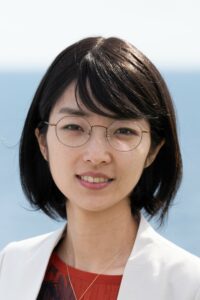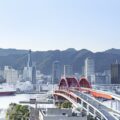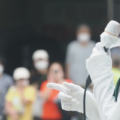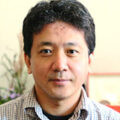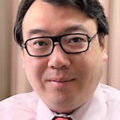Thoughts in Oslo: Inheriting the Essence of “No More Hibakusha”
*Translated from “Osuro de Kangaetakoto: No Moa Hibakusha wo Uketsugu tameni (Thoughts in Oslo: Inheriting the Legacy of No More Hibakusha),” Sekai, February 2025, pp. 26–33. (Courtesy of Iwanami Shoten, Publishers)
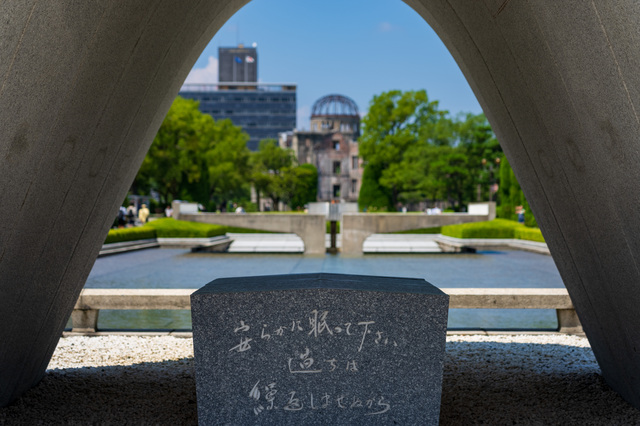
“Yasurakani nemutte kudasai, ayamachi wa kurikaeshimasenukara. (Let all the souls here rest in peace; for we shall not repeat the evil.)” This is the inscription on the Cenotaph for the A-bomb Victims in Hiroshima Peace Memorial Park. Beyond it you can see the so-called Atomic Bomb Dome. Approximately 140,000 people died in the atomic bomb dropped on Hiroshima, and approximately 70,000 people died in the atomic bomb dropped on Nagasaki. As of the end of March 2024, the number of atomic bomb survivors, hibakusha, exceeds 100,000.
Photo: HIT1912 / PIXTA
Hatakeyama Sumiko, Executive Committee Member of Peace Boat
Japan Confederation of A- and H-Bomb Sufferers Organizations (Nihon Hidankyo) was awarded the 2024 Nobel Peace Prize. Recently (December 10, 2024, Japan time), the Nobel Peace Prize award ceremony was held in Oslo, Norway. To attend the ceremony, more than 30 people, including Hiroshima and Nagasaki atomic bomb survivors (hibakusha) who are executives of Nihon Hidankyo and related parties, traveled to Oslo as an official delegation. In conjunction with this, Peace Boat, in cooperation with Gensuikyo (Japan Council Against A & H Bombs), planned the “Nihon Hidankyo Nobel Peace Prize Celebration Tour” so that many hibakusha, second and third generation atomic bomb survivors, related organizations, and individuals who had worked with Nihon Hidankyo in the past could share the joy in Oslo. I accompanied the latter tour and participated in a number of events, sometimes as an interpreter.
In the two months since it was decided that Nihon Hidankyo would be awarded the 2024 Nobel Peace Prize, I have been on a roller coaster of emotions, alternating between great joy and a tremendous sense of helplessness. Taking Nihon Hidankyo’s receipt of the Nobel Peace Prize as a starting point, I would like to turn my attention to the global nuclear situation and consider what guidelines we should follow to move forward in this increasingly chaotic world.
Hibakusha continue to expose themselves and tell their stories
At that time I was in a café. I was spending my Friday as usual, knowing that it was the day the 2024 Nobel Peace Prize would be announced (October 11, 2024). I was in a meeting with a colleague but decided to connect to the streaming service on my smartphone, thinking that I should at least take a look at the Norwegian Nobel Committee’s announcement of the prize. The moment the Chair of the Norwegian Nobel Committee said, “The Norwegian Nobel Committee has decided to award the Nobel Peace Prize for 2024 to the Japanese organization …,” the scenery around me seemed to go into slow motion. The next moment, I could barely hear “Nihon Hidankyo.” Even though it was not my organization receiving the prize, it was difficult to contain my excitement. Late that night I received a phone call from Tanaka Terumi, Co-Chairperson of Nihon Hidankyo. I spent a month with Tanaka when he joined the Peace Boat from Yokohama to South Africa last April (2024) to give testimonies [of the atomic bombing] on board the ship and around the world. I conveyed my heartfelt congratulations and promised to help with the press conference the next day, and then hung up.
The Norwegian Nobel Committee read out the reason for awarding the Nobel Peace Prize to Nihon Hidankyo as “This grassroots movement of atomic bomb survivors from Hiroshima and Nagasaki, also known as Hibakusha, is receiving the Peace Prize for its efforts to achieve a world free of nuclear weapons and for demonstrating through witness testimony that nuclear weapons must never be used again.”[1] While I understand that the Nobel Committee chose the word “witness testimony” to highlight the unique experience of hibakusha as witnesses of the bombing, the term “witness testimony” did not quite sit right with me. What the hibakusha have done is not just providing “witness” testimony. It has been much more. It has been to expose themselves. At the opening plenary session of the 2nd World Conference Against A and H Bombs held in 1956, which led to the formation of Nihon Hidankyo, Nagasaki hibakusha Chieko Watanabe (1928–93), who was paralyzed, took the stage in her mother’s arms and pleaded, “Please look at my miserable appearance. I don’t need to say much, but I think you can understand the horror of the atomic bomb.” It is well known that at the General Assembly of the Second Special Session on Disarmament (SSDII) of the United Nations in 1982, Yamaguchi Senji (1930–2013) stood at the podium in the UN General Assembly Hall, showed a photo of his own keloid scars, and appealed, “No More Hiroshima! No More Nagasaki! No More War! No More Hibakusha!” In fact, there were some words that preceded the famous line: “Please look at my face and hands. Please look at them carefully.” The hibakusha are not only witnesses to history, but have called for the abolition of nuclear weapons by exposing their own bodies and minds scarred by the atomic bomb. In the picture book Pikadon (1950) by Maruki Iri (1901–1995) and Toshi (1912–2000), painters known for their masterpiece The Hiroshima Panels, there is a line that reads, “There is no one who can tell what it was like at the hypocentre when the bomb dropped.” While countless people at the hypocenter were melted, burned, crushed, blown away, and lost their words as well as their lives, the survivors — the word “I was allowed to survive” is often used by hibakusha — have continued to help us “to describe the indescribable, to think the unthinkable,” as the Norwegian Nobel Committee states in its Announcement of the award. That is precisely why the words of the hibakusha have deterred the use of nuclear weapons. That is why their way of life has encouraged many people around the world who are working for nuclear disarmament and the abolition of nuclear weapons. While helping the hibakusha members, I also began to wish and act to help get closer to a “nuclear-free world” that the hibakusha aspire to. In this way, hibakusha have expanded the circle of people who are working to “never allow the use of nuclear weapons, and we will definitely abolish them one day.”
The Nobel Peace Prize was awarded 68 years after the foundation of Nihon Hidankyo and just before the 80th anniversary of the atomic bombing. I recall the faces of the hibakusha who have continued to campaign for the abolition of nuclear weapons at home and abroad. I also think of the people who would have been able to hear this news if the award had been given a little earlier. I wonder if the “congratulations” will reach heaven. On one hand, I feel that this came too late, but on the other hand, I also feel that this is just another milestone. And yet, when I think of the hibakusha who have spoken out, resisted and fought, who have had their hopes dashed so many times, but who have always stood up and called for the salvation of the hibakusha and the abolition of nuclear weapons, I think that the word “rewarded” was made for times like these.
The “nuclear taboo” is under threat
The Chair of the Norwegian Nobel Committee emphasizes that “The extraordinary efforts of Nihon Hidankyo and other representatives of the hibakusha have contributed greatly to the establishment of the nuclear taboo.” On the other hand, and this is another reason why Nihon Hidankyo was awarded the Nobel Peace Prize, he also points out that “It is therefore alarming that today this taboo against the use of nuclear weapons is under pressure.” Indeed, looking around the world, the risk of nuclear weapons being used is higher than ever. It is no exaggeration to say that the world is on the brink of nuclear war.
For the past three years, I have been teaching at a university as an adjunct professor in addition to my full-time job. The course consists of 14 classes dealing exclusively with nuclear issues. In the first few classes, students learn about the damage caused by the atomic bombings of Hiroshima and Nagasaki from different perspectives, and then we turn our attention to the “nuclear age”: since 1945, the nuclear arms race has continued around the world; nuclear tests have been conducted around the world with significant humanitarian and environmental consequences; and the power of each nuclear bomb has increased. With this in mind, students are surprised to learn that nine countries still possess more than 12,000 nuclear warheads: Russia, the United States, China, France, the United Kingdom, India, Pakistan, Israel, and the Democratic People’s Republic of Korea (North Korea). When they are told that 9,583 of these are “active nuclear warheads,” i.e., “deployable nuclear warheads” that are deployed and ready for use at any time, or “reserve nuclear warheads” that are stored in preparation for use, many students comment that they feel “scared.”
In fact, in terms of the number of nuclear warheads, the world has been on a steady decline since the end of the Cold War. Even if we look only at the last few years, when the security environment and the nuclear situation are said to be particularly tense, the number has decreased by several hundred each year. However, if we focus on the number of active nuclear warheads, the number has been increasing since 2018.[2] One of the reasons for this is that the New Strategic Arms Reduction Treaty (New START) between the United States and Russia expired in 2018. And there is no prospect of the two countries concluding a successor treaty to New START, which expires in 2026.
We should also look at the nuclear modernization plans of various countries. Nuclear modernization is the process of changing and updating obsolete parts to maintain and manage aging nuclear weapons systems. Modernization covers not only nuclear warheads, but also missiles, bombers, submarines, nuclear testing facilities, and many other areas. These steps represent a significant improvement in any country’s capabilities, so whether or not a country is pursuing nuclear modernization can be seen as an indicator of whether or not it is considering giving up its nuclear weapons. The nuclear-weapon states, led by the United States and Russia, are investing huge budgets in nuclear modernization plans to upgrade their old nuclear weapons to the latest ones, and at the same time they are accelerating the development of new nuclear weapons using cutting-edge technology. We are witnessing a current situation in which every country is moving towards continuing to possess nuclear weapons for decades to come, far from pursuing nuclear disarmament and abolition.
Against this backdrop, as Tanaka Terumi stated in his Nobel Prize lecture, “the ‘nuclear taboo’ threatens to be broken.” Russia launched a full-scale invasion of Ukraine in February 2022, and Russian President Vladimir Putin decided to deploy tactical nuclear weapons in Belarus in 2023. In November of the same year, Russia withdrew from ratification of the Comprehensive Nuclear-Test-Ban Treaty (CTBT), which it had signed in 2000 (the United States has not even ratified this treaty). In addition, on November 19, 2024, President Putin signed an executive order[3] amending the nuclear doctrine (Basic Principles of State Policy of the Russian Federation on Nuclear Deterrence), which defines the conditions for the use of nuclear weapons. The revised doctrine now states that “aggression against the Russian Federation and (or) its allies by any non-nuclear state with the participation or support of a nuclear state is considered as their joint attack” and that “nuclear deterrence is aimed to ensure that a potential adversary realizes the inevitability of retaliation in the event of aggression against the Russian Federation and (or) its allies.”[4] This theoretically lowers the bar for the first use of nuclear weapons and can be seen as a further strengthening of the nuclear threat.
It is well known that Amichai Eliyahu, Israeli Heritage Minister and a member of an extreme right-wing party, responded to a radio interviewer on November 3, 2023, by saying “that’s one way” when asked about dropping “some kind a nuclear bomb on all of Gaza, flattening them, eliminating everybody there….” Prime Minister Benjamin Netanyahu later commented on Amichai Eliyahu’s words, saying they were “detached from reality,” but it is hard not to be frightened by Israel’s possession of nuclear weapons as it continues its relentless assault on the Gaza Strip in Palestine.
The “Doomsday Clock,” which symbolically shows the remaining time until humanity’s extinction, has been pointing to the shortest time ever, “90 seconds,” for two consecutive years since 2023. The Bulletin of the Atomic Scientists, which announced the Doomsday Clock, said in a statement that “humanity continues to face an unprecedented level of danger.”[5] I seriously feel that if things continue as they are, we may not survive in this world. The phrase “existential threat” comes to mind and then disappears.
We who were handed the baton
At the end of the Nobel Prize lecture, Terumi Tanaka said, “I therefore appeal to everyone around the world to discuss together what we need to do to eliminate nuclear weapons, and to demand action from governments to achieve this goal,” and passed the baton to us, saying, “From now on, I hope that the next generation will find ways to build on our efforts and develop the movement even further. In a world where the nuclear threat has grown to such an extent, and where the number of atomic bomb victims who directly know the reality of the bombings is declining, the baton that Tanaka is about to pass on to us is extremely heavy. But I also think that we have to do it. Because “we must not allow the possession of a single nuclear weapon.” In the declaration “Message to the World” at the establishment meeting of Nihon Hidankyo, it says, “we have reassured our will to save humanity from its crisis through the lessons learned from our experiences, while at the same time saving ourselves.” I think that the “existential threat” I feel now is exactly synonymous with this “crisis” of humanity.
Where can we find the light? I got three hints in Oslo.
The first is the viewpoint of state compensation, which Tanaka emphasized in his Nobel Prize lecture, even going so far as to deviate from the prepared speech script. In the middle of his speech, Tanaka looked straight ahead and said, “Let me repeat what I have said one more time, I want you to know that the Japanese government has not provided any compensation to those who were killed in the atomic bombings.” Some have taken this passage literally and criticized it as being about money, but that is completely wrong. Nihon Hidankyo’s request for state compensation is a protest against the “endurance theory.” In 1980, the Conference for Fundamental Problems of Measures for the Victims of the Atomic Bombs, a national conference of academics, expressed the view that the so-called “endurance theory” also applies to the hibakusha.
“In general, under war, that is, the state of emergency which threatens the survival of the country, even when the war makes it unavoidable for the nationals to incur certain sacrifices regarding their lives, bodies, or properties, all the nationals have to equally endure the sacrifices as ‘general sacrifices’ due to the nation’s total war,” and “[…] leaves no way open to pursue legal responsibility, such as the state’s liability for torts, and to seek legal redress.”[6]
Nihon Hidankyo strongly opposed and protested this, and the demand for state compensation became one of the main pillars in their subsequent activism. There was a strong sense of crisis that no matter how recklessly the state pursues policies that harm its citizens, if the people tolerate them and do not demand compensation, then the disastrous policies that impose a heavy burden on the people will continue. Forcing states to acknowledge and take responsibility for the damage caused by war in the broadest sense will raise awareness of the enormous costs of war, raise the bar for war, and act as a deterrent to prevent similar incidents in the future. Therefore, what we can do to begin with is to “inherit” the essence of “No More Hibakusha” and “No More War” that Nihon Hidankyo tried to appeal to through its rejection of the endurance theory and its demand for state compensation.
Second, I think what we can do, especially the generation that did not directly suffer the atomic bomb or experience war, is to pay more attention to the damage caused by war in the past and present. What kind of damage did Japan cause to Asian countries in the war of aggression that the Japanese Empire waged in the past? What harm is being done to civilians in the wars currently raging around the world? We must face these questions head-on, bring them to light, and hold each government and the international community accountable. We must resist the discourse that says “endure and bear” the damage of war for the sake of the nation. We must build literacy against the discourse that incites excessive nationalism, so that we are not consumed by it. We must put the concepts of human security and common security at the center, and work to help the world move away from the values that have long supported the nuclear world, such as the idea that some lives are worth sacrificing for the sake of national and global security.[7]
Finally, I would like to emphasize that connecting with the world is our greatest tool and hope. As a result of the long-standing international movement of the hibakusha, including Nihon Hidankyo, and the history of each country’s own anti-nuclear movement, there are many active peace and anti-nuclear groups around the world. This time in Oslo, young staff members of the Norwegian branches of ICAN (International Campaign to Abolish Nuclear Weapons) and IPPNW (International Physicians for the Prevention of Nuclear War) arranged all the testimony sessions, media interviews, and dialogues with politicians and party officials during our stay. As I talked with them, I realized that we are facing similar challenges even though we are in different countries. Given the current international situation, many people in Norway believe that military power and nuclear deterrence cannot be abandoned. Many also said that the hurdle for Norway to join the Treaty on the Prohibition of Nuclear Weapons (TPNW) is high. I learned that even in Norway, far away from Japan, there are people who share the same aspirations and continue to work to move forward even in the face of headwinds. This gave me great strength. Do we assume that war is inevitable and nuclear deterrence indispensable, and promote global division in the name of alliances, or are we to rebuild international norms based on global solidarity? We are at a crossroads. I would like to choose the latter, while connecting across borders with people who share the same goal of a nuclear-free world.
Having humanity reflected in political ideology
More fundamentally, I think it is time to carefully rethink political ideology from the ground up. Okano Yayo, who studies feminist political theory with a focus on the “ethics of care,” refers to Joan Tronto’s (professor of political science at the University of Minnesota) definition of care and argues that “politics is nothing more than activities that we do to maintain, continue and repair our ‘world,’ so that we can live in it as well as possible.’”[8] She also states that “the most democratic stance the ‘ethics of care’ takes is to try to listen to the voices of others, others beyond our own imaginations.”[9]
In the spring of 2023, I had the opportunity to help a group of American university students who were on a week-long study tour of Hiroshima and Tokyo on the topic of global radiation history. One of the students, from Vietnam, like other students, saw the remains of the atomic bombing and listened intently to the testimonies of hibakusha. She also visited Okunoshima[10] in Takehara City, Hiroshima Prefecture, where she also learned about the history of Japan as the perpetrator. Her final impressions were as follows. It’s a bit long, but I’d like to quote it here.
I am a realist when it comes to international relations. I think global politics is a game theory in which every player wants to maximize their profit at the expense of others. My long-term career plan was to specialize in international law and development policy to make my hometown, Vietnam, a winner in this political game. After this trip, however, I feel more in touch with my idealism. Seeing charred bodies of Japanese from the bombing doesn’t upset me any less than seeing piling Vietnamese bodies in the My Lai massacre. I want to use my knowledge and skill sets for a broader humanity good and moral objective, in which nationality should never justify human sufferings. Becoming an idealistic realist, or a realistic idealist, to look beyond a nation’s interest into the future of mankind, I hope I could become somebody bigger and kinder than what my younger self could imagine.
I believe that people are human because they can imagine the pain of others. If this is the case, then I believe it is time to restore humanity to political thought and practice. Surely this will be a true response to what the hibakusha have been calling for all their lives.
References
Research Center for Nuclear Weapons Abolition (RECNA) of Nagasaki University, Sekai no Kakudanto Deta Kaisetsu 2024. 6 (World’s Nuclear Warhead Data 2024. 6)
Research Center for Nuclear Weapons Abolition (RECNA) of Nagasaki University, Sekai no Kakudanto Ichiran (2024, 6.1) (Global list of nuclear warheads [as of June 1, 2024])
https://www.recna.nagasaki-u.ac.jp/recna/en-nwdata/list_of_nuclear_2023 (2023 edition)
Hidankyo’s History Editorial Committee, Japan Confederation of A- and H-Bomb Sufferers Organizations, Futatabi Hibakusha wo Tsukuruna (Honkan): Nihon Hidankyo 50-nen shi 1956–2006 (Create No More Hibakusha (main volume): 50-Year History of Hidankyo 1956–2006) (Akebi Shobo)
Japan Confederation of A- and H-Bomb Sufferers Organizations (Nihon Hidankyo) 2021 Hibakusha kara Anatani: Ima tsutaetaikoto (From Hibakusha to you: What we want to tell you now) (Iwanami Shoten)
Nobel Foundation 2024 “Nobel Peace Prize lecture by Terumi Tanaka from Nihon Hidankyo”
https://www.nobelprize.org/prizes/peace/2024/nihon-hidankyo/lecture/
Translated from “Osuro de Kangaetakoto: No Moa Hibakusha wo Uketsugu tameni (Thoughts in Oslo: Inheriting the Legacy of No More Hibakusha),” Sekai, February 2025, pp. 26–33. (Courtesy of Iwanami Shoten, Publishers) [February 2025]
[1] Norwegian Nobel Committee “Announcement” (October 11, 2024)
http://www.nobelprize.org/prizes/peace/2024/press-release
[2] The countries with the highest rate of increase in the number of active nuclear warheads over the six-year period from 2018 to 2024 are North Korea (233%), China (108%), India (36%), and Pakistan (21%). Although Russia’s rate of increase is lower than these countries, it ranks third in terms of absolute increase in numbers, as it possesses an overwhelming number of nuclear warheads alongside the United States. The United States is the only country among the nine to have reduced its number, but as will be described later, it has been actively modernizing its nuclear weapons, and this has continued regardless of changes in administration.
[3] President of Russia. “Executive Order Approving the Basic Principles of State Policy of the Russian Federation on Nuclear Deterrence: Vladimir Putin signed Executive Order Approving the Basic Principles of State Policy of the Russian Federation on Nuclear Deterrence (November 19, 2024).” http://en.kremlin.ru/events/president/news/75598
[4] The Ministry of Foreign Affairs of the Russian Federation “Fundamentals of State Policy of the Russian Federation on Nuclear Deterrence (December 3, 2024)” https://www.mid.ru/en/foreign_policy/international_safety/1434131/
[5] Bulletin of the Atomic Scientists “A moment of historic danger: It is still 90 seconds to midnight 2024 Doomsday Clock Statement (January 23, 2024)” https://thebulletin.org/doomsday-clock/2024-statement/
[6] “On Fundamental Principles and the Fundamental State of Measures for Atomic Bomb Survivors,” the Conference for Fundamental Problems of Measures for the Victims of the Atomic Bombs (December 11, 1980)
https://www.mhlw.go.jp/shingi/2007/09/dl/s0928-9h.pdf (in Japanese)
[7] Regarding the fact that a world with nuclear weapons is a world that exists only at the expense of many vulnerable people, please refer to my article in the February 2024 issue of Sekai entitled Zetsubo to Kibo ga Tonariawaseno Kono Sekai de, Naze Kodosuruka (Why do we act in a world where despair and hope coexist?).
[8] Okano Yayo, Kea no Rinri: Feminizumu no Seiji Shiso (Ethics of care: Feminist political thought) (Iwanami Shinsho, 2024), p. 318
[9] Same as above, p. 23
[10] Okunoshima is an island 3 km off the coast of Takehara City, Hiroshima Prefecture, where poison gas was manufactured under the control of the Imperial Japanese Army from the early Showa period until the end of the war. The Okunoshima Poison Gas Victims Memorial was built in 1985, and the Okunoshima Poison Gas Museum was built in 1988.
Keywords
- Hatakeyama Sumiko
- Peace Boat
- Waseda University
- atomic bomb
- A-bomb
- H-bomb
- Hiroshima
- Nagasaki
- hibakusha
- atomic bomb survivors
- Nihon Hidankyo
- Japan Confederation of A- and H-Bomb Sufferers Organizations
- Nobel Peace Prize
- Gensuikyo
- Japan Council Against A & H Bombs
- Tanaka Terumi
- “nuclear-free world”
- abolition of nuclear weapons
- nuclear taboo
- nuclear age
- nuclear arms race
- New START
- nuclear deterrence
- Doomsday Clock
- endurance theory
- ICAN
- IPPNW
- Treaty on the Prohibition of Nuclear Weapons
